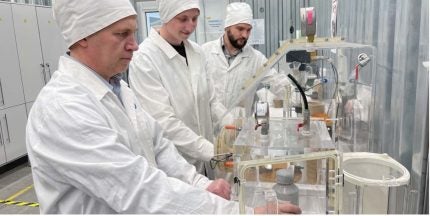
Specialists at Russia’s AA Bochvar Research Institute of Inorganic Materials (VNIINM, part of Rosatom’s TVEL fuel company) have developed composite fuel shells based on silicon carbide. The use of digital twin technology saved time and money on the experiments.
Tolerant fuel with silicon carbide shells will not only minimise, but completely eliminate the risk of a steam-zirconium reaction – the main cause of almost all past accidents at NPPs. But this material is unpredictable and fragile, and it is impossible to make fuel tubes from it using technology developed for metals. VNIINM proposed another method – a frame woven from silicon carbide fibre and impregnated with a matrix material based on the same silicon carbide.
The basic technology was understood, but developers still had many questions. At what angle should the fibres be wound when weaving? What is the optimal thickness of a monolithic silicon carbide part? How to achieve a sealed shell? VNIINM engineer Alexey Sorokin used a digital twin to help to find the answers.
Sorokin is a programmer and physicist who studied at the Moscow Energy Institute’s Department of Engineering Thermophysics. In the third year, he joined the modelling group and began to develop calculation codes for thermal and thermophysics. At VNIINM, he was given a specific task – numerical modelling of the behaviour of a fuel rod with a composite cladding.
“The double is a set of digital calculation models,” he explained. “A library of material properties has been collected for it – the shell, the end element of the fuel rod and their solder joint. Numerical models of mechanical tests and main components of fuel rods are ready. As data is received, the digital twin will be updated with models.”
The twin is already helping to reduce the number of experiments.: “There is no need to make 20 expensive samples with different fibre winding angles and study the mechanical characteristics of each,” said Sorokin. “They can be simulated by calculation and the optimal winding angle can be determined.”
Researchers examine the sample and describe the initial geometry, the loading process, and the strength of the sample’s resistance to the applied load. Sorokin recreates a numerical model of mechanical testing in the calculation code, verifies it – and it is possible to conduct a numerical study and select optimal parameters. “For example, a tensile experiment on a tubular sample. I made a model and looked at the experimental data. Then I conducted research and found out in which weaving configuration the strength characteristics would be better, and gave feedback to the technologists.”
Developers of silicon carbide claddings are thinking about how to achieve gas-tightness of fuel rods during operation. There is an idea to add an intermediate layer of metal liner from the standard E110 alloy. A digital twin will help to calculate its thickness.
Sorokin carries out calculations using the foreign code Abaqus, based on the finite element method (FEM). In parallel with other computer modelling specialists, he is developng import-substituting codes “Startup” and PK3D.
The digital twin of silicon carbide-based fuel cladding manufacturing technology will be developed along with research and development work on the project as a whole. “Any new information, any new test should complement the twin, expand the digital model of the object,” Sorokin noted. “The twin will be completely ready when we introduce the technology into production. It will, of course, be improved all the time: the industry is constantly fighting to improve the energy efficiency of nuclear fuel.”
The development of composite fuel claddings at VNIINM began in 2014. By the end of 2023, 55 samples had been manufactured of 11 types of gas-tight shell pipes up to 500 mm long with different weaving architectures, frame compaction methods, and deposition modes of the silicon carbide matrix and interphase layer.
The first reactor tests of silicon carbide shells in Russia were a milestone. Last summer, the Research Institute of Atomic Reactors (NIIAR) completed the first irradiation cycle in the BOR-60 research reactor. Tests took place at temperatures up to 360 °C. By 2030, VNIINM specialists have to make optimised sealed gas-tight claddings of fuel rods up to 1 metre long and conduct a set of pre-reactor tests to check compatibility with the nuclear fuel.


